Micro Star MS3871 WLAN 802.11b/g/n 1T1R+BT2.1 EDR COMBO SLIM MODULE User Manual MS 3871
Micro Star International Co Ltd WLAN 802.11b/g/n 1T1R+BT2.1 EDR COMBO SLIM MODULE MS 3871
Contents
Users Manual

i
MSI MS-3871
Wireless 11b/g/n + Bluetooth BT2.1 EDR
Combo Slim Module
User’sGuide

ii
FCC Caution
1. The device complies with Part 15 of the FCC rules. Operation is subject to
the following two conditions:
(1) This device may not cause harmful interference, and
(2) This device must accept any interference received, including interference
that may cause undesired operation.
2. FCC RF Radiation Exposure Statement: The equipment complies with FCC
RF radiation exposure limits set forth for an uncontrolled environment.
This equipment should be installed and operated with a minimum
distance of 20 centimeters between the radiator and your body.
3. This Transmitter must not be co-located or operating in conjunction with
any oth er anten na or transmitter.
4. Changes or modifications to this unit not expressly approved by the
party responsible for compliance could void the user authority to operate
the equipment.
FCC Statement
This device is intended only for OEM integrators under the following
1) The antenna must be installed such that 20 cm is maintained between antenna
and users, and
2) The transmitter module may not be co-located with any other transmitter or
antenna.
As long as 2 conditions above are met, further transmitter test will not required. However,
the OEM integrator is still responsible for testing end-product for any additional compli-
ance requirements required with module installed (for example, digital device emissions,
PC peripheral requirements, etc.).
Important Note
In the event that these conditions can not be example certain laptop configurations or co-
location with another transmitter), then the FCC authorization is no longer considered
valid the FCC ID can not be used on the final product. In these circumstances, OEM
integrator will be responsible for re-evaluating the end product (including the transmitter)
and obtaining a separate FCC authorization.

iii
End Product Labeling
This transmitter module is authorized only for use in device where antenna may be
installed such that 20 cm may be maintained between antenna and users (for example
access points, routers, wireless ADSL and similar equipment). The final end product
must be labeled in a area with the following: “Contains TX FCC ID: I4L-MS3871”.
Manual Information for End Users
The end user must not have manual instructions to remove or install device. The user
manual for end users must include the following information in a prominent location:
“IMPORTANT NOTE: To comply with FCC RF exposure compliance requirements,
the antenna used for this transmitter must be installed to provide a separation distance of
at least 20 cm from all persons and must not be co-located operating in conjunction with
any other antenna or transmitter.” as a result of e-mail transmission.”
Important Safety Precautions
Always read and follow these basic safety precautions carefully when handling any
piece of electronic component.
1. Keep this User’sGuide for future reference.
2. Keep this equipment away from humidity.
3. Lay this equipment on a reliable flat surface before setting it up.
4. The openings on the enclosure are for air convection hence protects the
equipment from overheating.
5. All cautions and warnings on the equipment should be noted.
6. Never pour any liquid into the opening that could damage or cause electrical
shock.
7. If any of the following situations arises, get the equipment checked by a
service personnel:
Liquid has penetrated into the equipment
The equipment has been exposed to moisture
The equipment has not work well or you can not get it work
according to User’s Manual
The equipment has dropped and damaged
If the equipment has obvious sign of breakage
8. DO NOT LEAVE THIS EQUIPMENT IN AN ENVIRONMENT
UNCONDITIONED, STORAGE TEMPERATURE ABOVE 100OCOR
BELOW -20OC, IT MAY DAMAGE THE EQUIPMENT.

1
Introduction
MSI latest combo module MS-3871, the Wireless 11b/g/n+
Bluetooth Combo Slim Module, which can be used to integrate
with such systems as notebook, mini-barebone, portable PC.
With MSI MS-3871embedded inside, a system could provide
users with the ability and flexibility to connect up to Internet
wirelessly via 802.11b/g/n with speed up to 150Mbps, and to
link with peripherals wirelessly through BluetoothTM v2.1 and
advanced EDR (Enhanced Data Rate) technology. BluetoothTM
v2.1 technology increases the data rate of BluetoothTM v1.1/1.2
from 1.0Mbps to 2.1Mbps.
MSI MS-3871is taking advantage of leading technologies from
Ralink and CSR. It addresses the co-existence issues in PAN
(Personal Area Network) and WLAN (Wireless Local Area
Network) markets by providing true simultaneous connectivity
while deploying IEEE 802.11b/g/n and Bluetooth v2.1 Along
with this combo solution, a system installed with a single mod-
ule is able to offer dual mode capability of WiFi and BluetoothTM.
It will benefit system vendors in miniaturization of system di-
mension and BOM cost reduction, as well as also make users
happy with the all-in-one functionality.
>>> 1.1 MSI MS-3871 - Wireless 11b/g/n +
Bluetooth BT2.1 Combo Slim Module
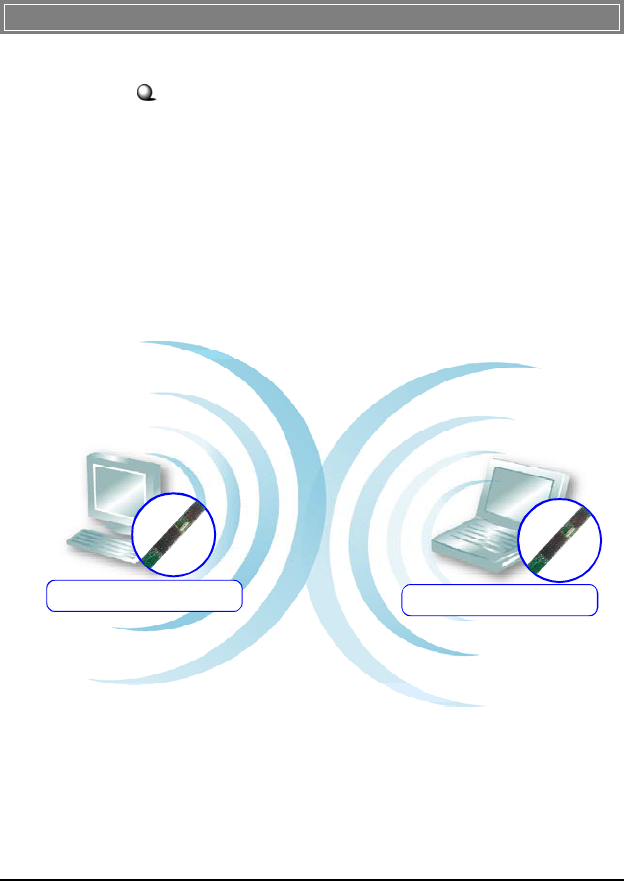
2
Ad-hoc Mode : An Ad-hoc network is a local area network or
other small network, especially one with wireless or temporary
plug-in connections, in which some of the network devices are
part of the network only for the duration of a communications
session. Users in the network can share files, print to a shared
printer, and access the Internet with a shared modem. In this
kind of network, new devices can be quickly added; however,
users can only communicate with other wireless LAN comput-
ers that are in this wireless LAN workgroup, and are within
range.
>>> 1.2 How MS-3871 Works
MS-3871 MS-3871
In WLAN Environment1.2.1
WLAN+Bluetooth Combo Slim Module WLAN+Bluetooth Combo Slim Module
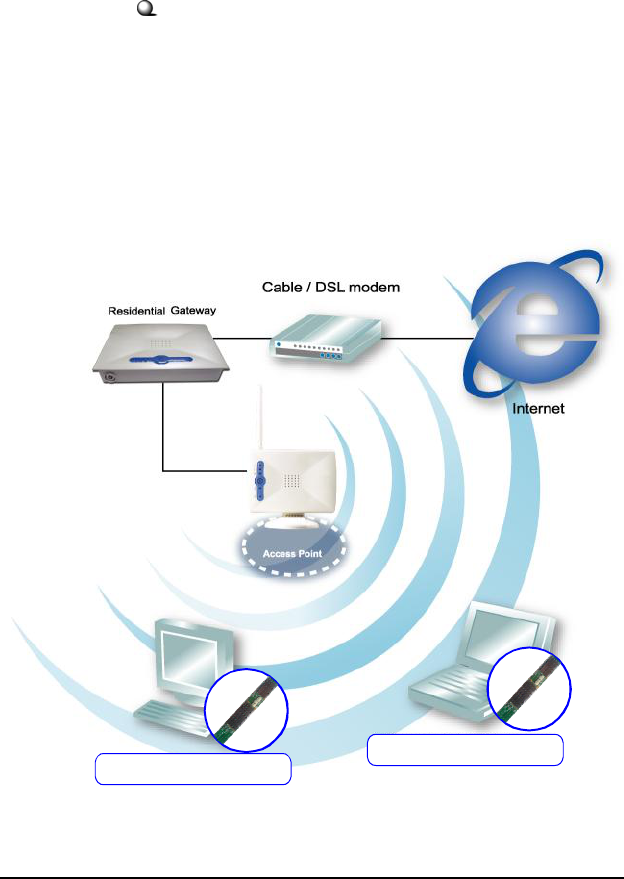
3
Infrastructure Mode : The difference between Infrastructure
network and Ad-hoc network is that the former one includes an
Access Point. In an Infrastructure network, the Access Point can
manage the bandwidth to maximize bandwidth utilization. Addi-
tionally, the Access Point enables users on a wireless LAN to
access an existing wired network, allowing wireless users to take
advantage of the wired networks resources, such as Internet,
email, file transfer, and printer sharing. The scale and range of the
Infrastructure networking are larger and wider than that of the
Ad-hoc networking.
MS-3871
MS-3871
WLAN+Bluetooth Combo Slim Module
WLAN+Bluetooth Combo Slim Module
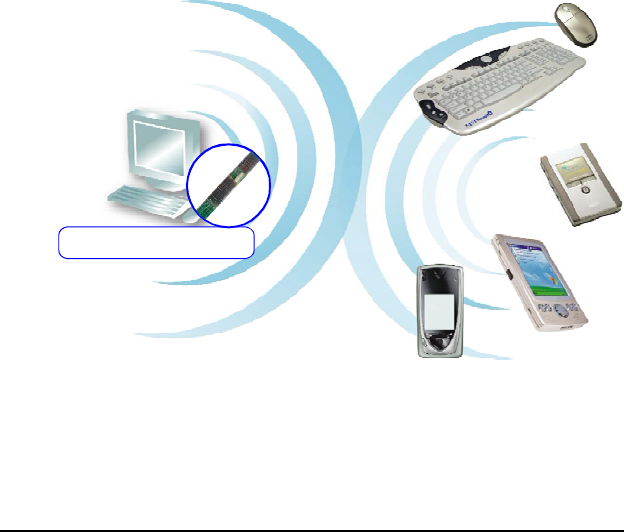
4
In Bluetooth Connection
The term “Bluetooth” refers to a worldwide standard for the
wireless exchange of data between two devices. In order to ex-
change data, two Bluetooth devices must establish a connection.
Before a connection is established, one device must request a
connection with another. The second device accepts (or rejects)
the connection. The originator of the request is known as the
client. The device that accepts (or rejects) the request is known
as the server. Many Bluetooth devices can act as both client and
server. Every Bluetooth device that provides a service must be
prepared to respond to a connection request. Bluetooth soft-
ware is always running in the background on the server, ready to
respond to connection requests.
1.2.2
Bluetooth-enabled Devices
WLAN+Bluetooth Combo Slim Module
MS-3871

5
>>> 1.3 Specifications
Operation voltage 3.3V+/-10%
Operating System Microsoft®W indows®XP 32/ 64-bit,
Vista 32/64-bit, W in7 32/64-bit
Environmental - Operating Temperature:
0~65
OC
- Operating Humidity:
10 ~ 90%, non-condensing
Dimensions (W xDxH) 80 x 6x3mm
Weight 3.5g
Hardware
Specification

6
Network Standard IEEE 802.11b/g/n
Frequency Band 2.400-2.4835 GHz
Data Rate IEEE 802.11b (auto-fallback):
- CCK: 11, 5.5 Mbps
- DQPSK: 2 Mbps
- DBPSK: 1 Mbps
IEEE 802.11g (auto-fallback):
- OFDM: 54, 48, 36, 24, 18, 12, 9 and
6Mbps
IEEE 802.11n (auto-fallback):
-OFDM: 6.5 to 150 Mbps
(Follow MCS 0~7 standard)
Media Access Control CSMA/CA with ACK
Transmission IEEE 802.11b (DSSS),
IEEE 802.11g/n (OFDM)
Network Architecture Ad-hoc Mode (Peer-to-Peer);
Infrastructure Mode
Antenna Type PCB printed antenna
Power Consumption 802.11b (11 Mbps):
328mA@3.3V in continuous Tx
231mA@3.3V in Rx
802.11g (54Mbps):
313mA@3.3V in continuous Tx
233mA@3.3V in Rx
802.11n:
HT20MHz: 308mA@3.3V in continuous
Tx / 232mA@3.3V in Rx (MCS7)
HT40MHz: 325mA@3.3V in continuous
Tx/ 283mA@3.3V in Rx (MSC7)
233mA@3.3V in standby mode
WLAN
Specification

7
Channel IEEE 802.11g/n:
Ch. 1-11 – N. America
Ch. 1-13 – Japan
Ch. 1-13 – Europe ETSI
Ch. 10-11 – Spain
Ch. 10-13 – France
IEEE 802.11b:
Ch. 1-11 – N. America
Ch. 1-14 – Japan
Ch. 1-13 – Europe ETSI
Ch. 10-11 – Spain
Ch. 10-13 – France
Output Power 802.11b (11Mbps): 17.0 +/-1 dBm
802.11g (54Mbps): 14.0 +/-1 dBm
802.11n : 13.0 +/-1 dBm
Receiver Sensitivity 802.11b (11Mbps): CCK@8% PER = -76dBm
(Typical Value) 802.11g (54Mbps): OFDM@10% PER = -65dBm
802.11n draft 6.0:
HT20 @ 10% PER = -64 dBm
HT40 @ 10% PER = -61dBm

8
Network Standard Bluetooth v2.1 Class II +EDR
Frequency Band 2.400 - 2.4835 GHz
Data Rate Up to 3Mbps
Channel 79 sub-channels
Transmission FHSS (Frequency Hopping Spread
Spectrum)
Modulation n/4 DQPSK@2Mbps, 8DQPSK@3Mbps
Antenna Type PCB printed antenna
Power Consumption 66mA in continuous Tx
8.6mA in standby mode
Max. Output Power -4~4 dBm
Max. Input Level -20 dBm@BER<0.1%
Receiver Sensitivity -82dBm @ BER<0.1%
Range Up to 10 m operating range
(outdoor operating range)
Physical Links Support ACL and SCO link
Network Capabilities Support piconet point-to-point and
point-to multipoint connections
Link Manager 3-slot Packets: Yes
5-slot Packets: Yes
Slot Offset: Yes
Timing Accuracy: Yes
Switch: Yes
Hold Mode: Yes
Sniff Mode: Yes
Tes t Mode: Yes
Park Mode: Yes
RSSI: Yes
Power Control: Yes
Authentication: Yes
Encryption: Yes
Bluetooth
Specification
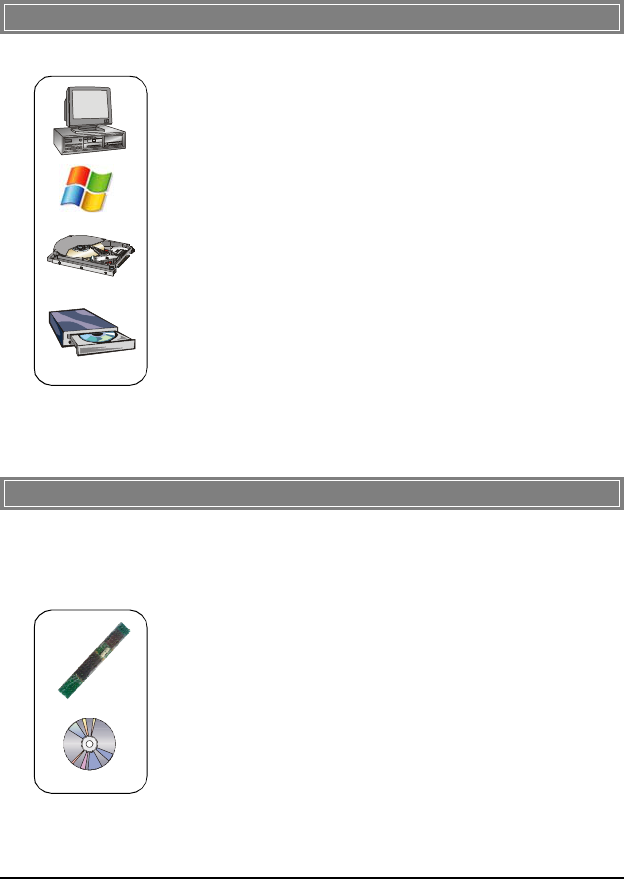
9
>>> 1.4 System Requirements
Before installing MS-3871, your PC should meet the following
items:
- Windows®XP 32/ 64-bit, Vista 32/64-bit, Win7 32/64-bit
operating system.
- Minimum 5MB free disk space for installing the driver and
utilities.
- One CD-ROM drive, double speed or higher.
>>> 1.5 Package Contents
Unpack the package and check all the items carefully. If any item
contained is damaged or missing, please contact your local dealer
as soon as possible. Also, keep the box and packing materials in
case you need to ship the unit in the future. The package should
contain the following items:
- One Wireless 11b/g/n + Bluetooth Combo Slim Module.
- One Installation CD-ROM including drivers, utilities, and the
manual files.
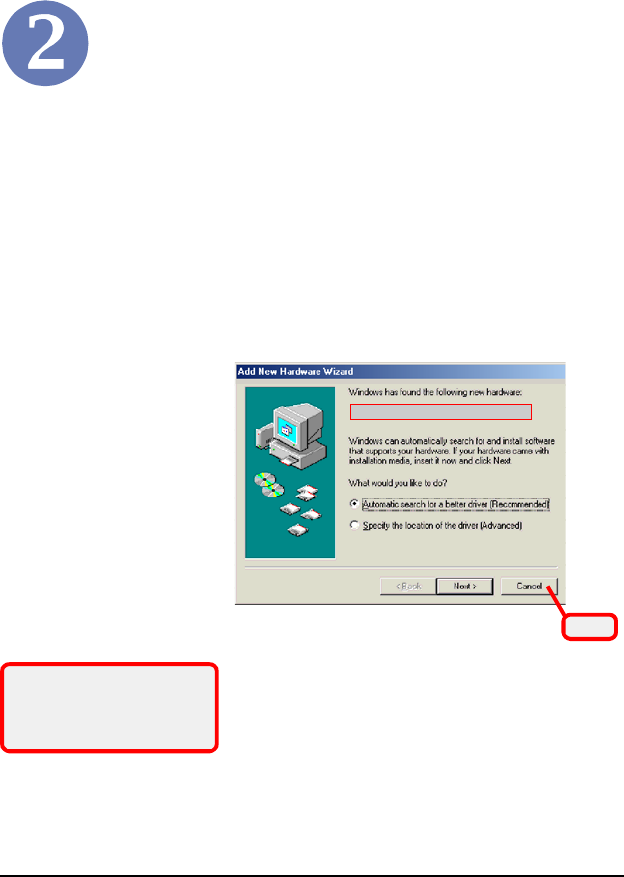
10
Software Installation
This chapter describes the procedures of installing the driver
and utility. Follow the instruction step by step to finish the
installation. If you use Windows®98SE/ME, please prepare
the Windows®Setup CD at hand before installing the driver;
because the system will ask you to insert the Setup CD to copy
files during the installation.
Please NOTE that the MS-3871should be installed into your
computer before installing the driver and utility. Then, the
operating system will detect a new device and start to configure
the new device. Click Cancel here to start installation from the
InstallShield Wizard.
Click
Tip: The MS-3871 adapter
should be installed into your PC
before installing the driver and
utility.
The adapter model you installed
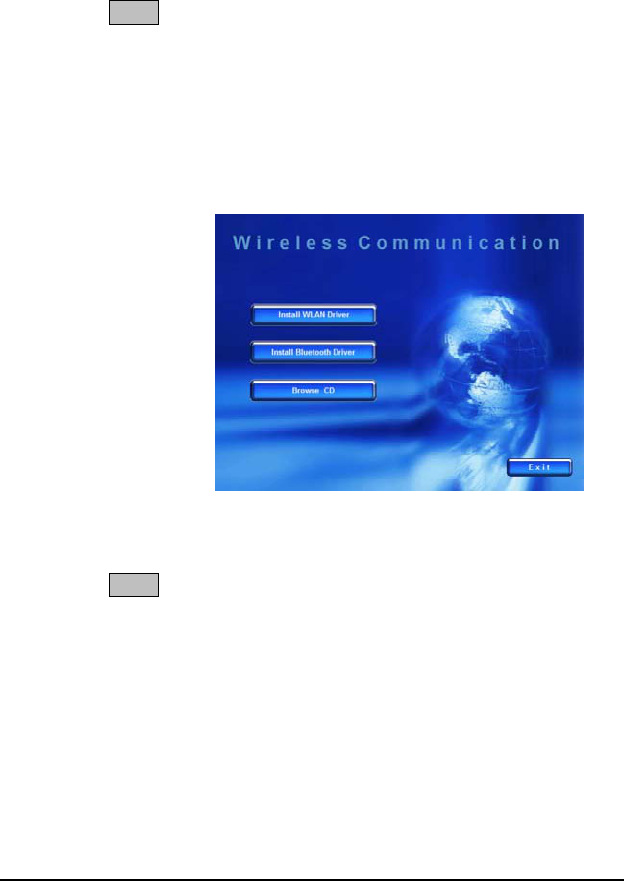
11
Insert the software CD into your CD-ROM drive, and the Setup
program should launch automatically.
If the Autorun program doesn’t launch automatically, click Start
at the taskbar and select Run....TypeE:\setup.exe (where Eis
your CD-drive) in the Open box and click OK to launch the
Setup program manually.
The main screen of Setup program will appear as below.
1. Click the Install WLAN Driver button.
2. The welcome screen of InstallShield Wizard appears.
Click Next.
3. Read and accept the License Agreement; then, click Next.
4. Click Install and the program will copy the necessary
files to the system. The progress indicator shows the
installing status.
5. Click Finish when the WLAN driver installation is
completed.
STEP1
STEP2
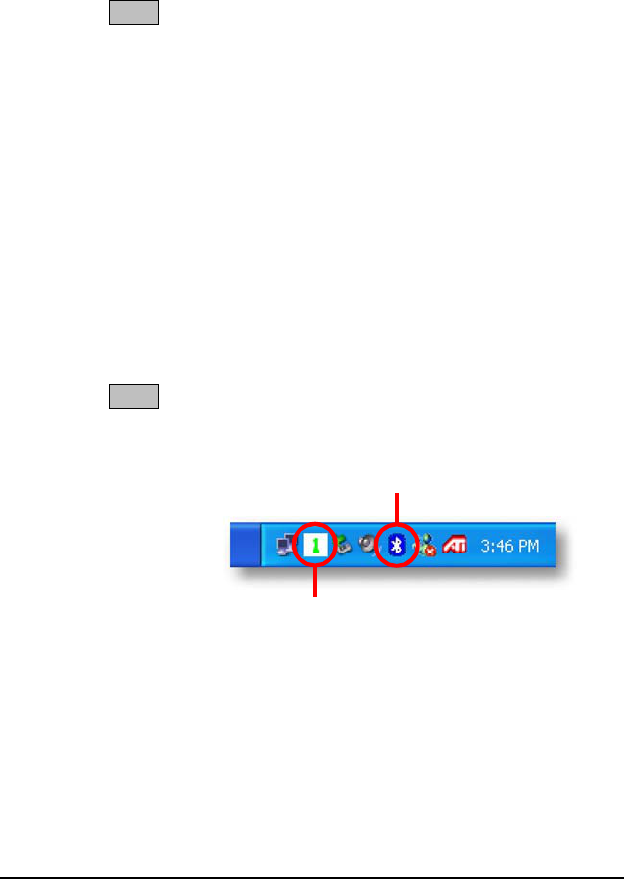
12
1. Click the Install Bluetooth Driver button.
2. The welcome screen of InstallShield Wizard appears.
Click Next.
3. Read and accept the License Agreement; then, click Next.
4. Click Next to install the driver in the default destination
folder.
5. Click Install and the program will copy the necessary
files to the system. The progress indicator shows the
installing status.
6. Click Finish when the bluetooth driver installation is
completed.
Wireless LAN icon
STEP3
STEP4Click the Exit button.
The Wireless LAN icon and Bluetooth icon will appear in the
status bar.
Bluetooth icon
FEDERAL COMMUNICATIONS COMMISSION INTERFERENCE STATEMENT
This equipment has been tested and found to comply with the limits for a Class B digital device,
pursuant to Part 15 of the FCC Rules. These limits are designed to provide reasonable protection
against harmful interference in a residential installation. This equipment generates, uses and can
radiate radio frequency energy and, if not installed and used in accordance with the instructions,
may cause harmful interference to radio communications. However, there is no guarantee that
interference will not occur in a particular installation. If this equipment does cause harmful
interference to radio or television reception, which can be determined by turning the equipment off
and on, the user is encouraged to try to correct the interference by one or more of the following
measures:
– Reorient or relocate the receiving antenna.
– Increase the separation between the equipment and receiver.
– Connect the equipment into an outlet on a circuit different from that to which the receiver is
connected.
– Consult the dealer or an experienced radio/TV technician for help.
CAUTION:
Any changes or modifications not expressly approved by the party responsible for compliance
could void the user's authority to operate the equipment.
This device complies with Part 15 of the FCC Rules. Operation is subject to the following two
conditions:
(1) This device may not cause harmful interference and
(2) This device must accept any interference received, including interference that may cause
undesired operation.
RF exposure warning ·
This equipment must be installed and operated in accordance with provided instructions and the
antenna(s) used for this transmitter must be installed to provide a separation distance of at least
20 cm from all persons and must not be co-located or operating in conjunction with any other
antenna or transmitter. End-users and installers must be provide with antenna installation
instructions and transmitter operating conditions for satisfying RF exposure compliance.